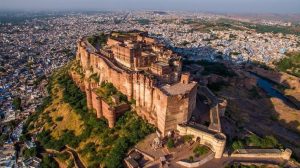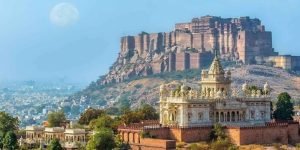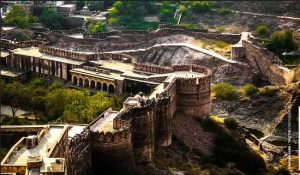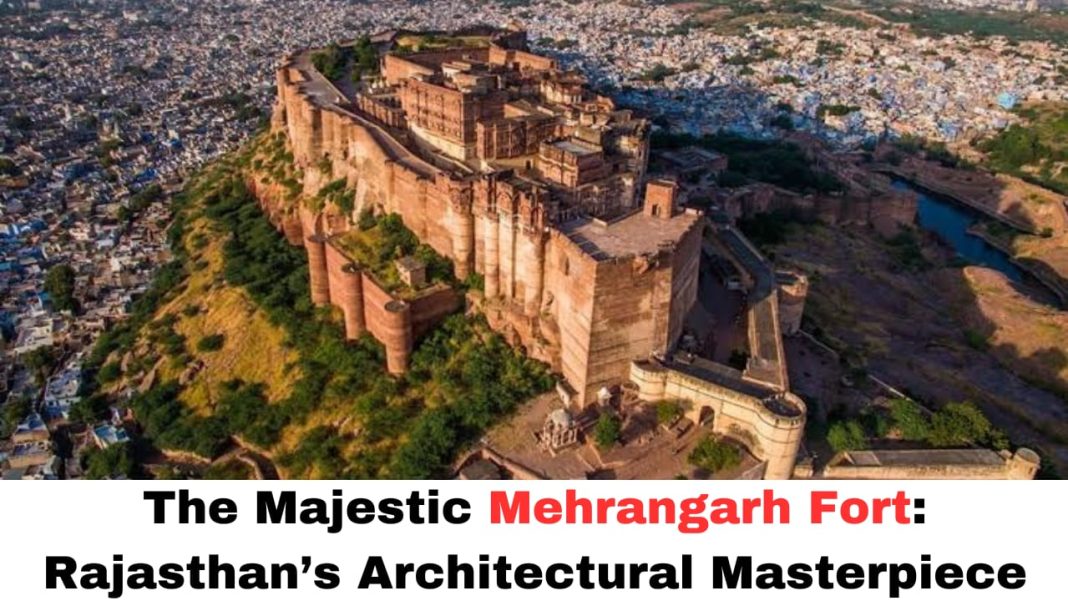Digital News Guru Rajasthan Desk:
Mehrangarh Fort, Jodhpur: A Majestic Icon of Rajasthan’s Heritage
Towering over the vibrant blue city of Jodhpur, Mehrangarh Fort is one of the most magnificent and well-preserved forts in India. Known for its architectural brilliance, historical significance, and breathtaking views, this majestic structure is a testament to Rajasthan’s royal legacy and cultural richness.
Built in the 15th century by Rao Jodha, the founder of Jodhpur, the fort serves as a symbol of resilience and grandeur. Today, it stands as a popular tourist destination, captivating visitors with its impressive architecture, intricate carvings, and rich history.
Historical Overview
The origins of Mehrangarh Fort trace back to 1459, when Rao Jodha decided to move his capital from Mandore to a more secure location. He selected the Bhakurcheeria Hill, also known as the “Mountain of Birds,” to construct the fort. According to legend, the hill was home to a hermit, Cheeria Nathji, who initially opposed the construction. To appease him, Rao Jodha built a house for the hermit within the fort premises, a gesture that signifies the blending of power and spirituality in Rajput culture.

Over the centuries, the fort underwent numerous additions and modifications by successive rulers, each leaving their mark on its architecture and design.
Architectural Marvel
Mehrangarh Fort is an architectural masterpiece, combining Rajput and Mughal styles. It rises to a height of 410 feet above the city, with its massive walls and intricately designed gates blending seamlessly into the rugged terrain.
The fort is accessed through seven imposing gates, each with historical significance. Notable gates include:
- Jai Pol (Gate of Victory): Built to commemorate a victory over the Jaipur and Bikaner armies.
- Fateh Pol (Gate of Victory): Erected after the defeat of the Mughals.
- Dedh Kangra Pol: This gate still bears scars from cannonball attacks, serving as a reminder of past battles.
The interiors of the fort are equally stunning, featuring palaces, courtyards, galleries, and temples that reflect the opulence of the Rajput rulers.
Attractions within the Fort
- Sheesh Mahal (Mirror Palace):
A glittering room adorned with intricate mirror work, Sheesh Mahal reflects the artistic brilliance of the Rajput era. - Phool Mahal (Flower Palace):
Known as the grandest palace in Mehrangarh, Phool Mahal was designed as a pleasure chamber for the royal family. Its walls are embellished with gold filigree, paintings, and ornate decorations. - Moti Mahal (Pearl Palace):
A palace where the king held court, Moti Mahal features large windows and balconies, allowing rulers to interact with their subjects while maintaining their grandeur. - Chamunda Mataji Temple:
Dedicated to the goddess Chamunda, this temple is an important spiritual site for the people of Jodhpur and hosts vibrant celebrations during Navratri.
- The Museum:
Mehrangarh Fort houses one of the finest museums in Rajasthan, showcasing a remarkable collection of artifacts, including weapons, costumes, paintings, and royal cradles. The museum provides a glimpse into the lives of the royal family and the rich cultural heritage of the region.
Mehrangarh’s Cultural Legacy
Mehrangarh Fort is not just a historical monument; it is also a hub of cultural activities. The fort hosts various events and festivals, including the Rajasthan International Folk Festival (RIFF) and the World Sacred Spirit Festival, which celebrate music, art, and spirituality. These events draw artists and audiences from around the globe, transforming the fort into a vibrant cultural center.
The fort’s association with art and cinema has further elevated its profile. Several Bollywood and Hollywood films, including “The Dark Knight Rises,” have featured Mehrangarh Fort, highlighting its global appeal.
Spectacular Views
One of the most enchanting aspects of visiting Mehrangarh Fort is the panoramic view it offers of Jodhpur, famously known as the “Blue City.” The sight of hundreds of blue-painted houses below the fort creates a mesmerizing contrast with the golden hues of the fort’s sandstone walls, making it a photographer’s paradise.
Visiting Mehrangarh Fort
Mehrangarh Fort is open to visitors throughout the year, though the best time to visit is during the winter months (October to March) when the weather is pleasant. The fort offers guided tours, audio guides, and cultural performances, enhancing the visitor experience.

Visitors can explore the fort’s sprawling courtyards, climb its bastions, and marvel at its historical artifacts. For adventure seekers, the fort offers a unique zip-lining experience, allowing them to glide over its scenic surroundings.
Legends and Myths
Mehrangarh Fort is steeped in legends. One of the most intriguing stories is that of Rao Jodha’s curse. It is said that a man named Raja Ram Meghwal was buried alive beneath the foundation to appease the gods and ensure the fort’s prosperity. His descendants are believed to have been compensated and are considered guardians of the fort’s sanctity.
Conclusion
Mehrangarh Fort is more than a historical monument; it is a living embodiment of Rajasthan’s royal heritage and cultural pride. Its towering walls, intricate palaces, and enduring legends make it a must-visit destination for history enthusiasts, architecture lovers, and travelers seeking to experience the grandeur of India’s past.
As you walk through its ancient gates and explore its regal interiors, you are transported to an era of valor, opulence, and artistry. A visit to Mehrangarh Fort is an unforgettable journey into the heart of Rajasthan’s history and splendor.
You May Also Read: Vadodara’s Pride: The Story of Laxmi Vilas Palace








